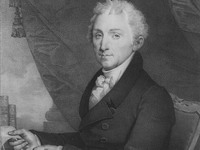Login form
James Monroe

It was a time of so few political battles that people called it the Era of Good Feelings. The years were 1817 to 1825. James Monroe was president of the United States, the nation’s fifth president. The United States was at peace at last after wars with Great Britain, and American politicians had stopped their bitter squabbling.
When Monroe was born, North and South America were ruled or claimed by European countries. By the end of Monroe’s presidency, much of the Americas had been freed of European control. A policy called the Monroe Doctrine declared that the United States would keep it that way.
EARLY LIFE
James Monroe was born in 1758 in Westmoreland County, Virginia. At age 16, in 1774, Monroe entered the College of William and Mary. But after a year, he left college to fight in the American Revolution. In 1779, Monroe returned to Virginia.
ENTERING POLITICS
Monroe worked for Thomas Jefferson, Virginia’s governor. He also studied law with Jefferson. Law and government service inspired young Monroe. He wrote, "My plan of life is now fixed."
Monroe was elected to the Virginia legislature at age 24, in 1782. From 1783 to 1786, he represented Virginia at the Congress of the Confederation, which governed the country then.
In 1786, Monroe married Elizabeth Kortright. They moved to Virginia, and Monroe started a law practice. The couple had two daughters.
IN THE SENATE
Monroe served in the U.S. Senate from 1790 to 1794. At this time, Congress was bitterly divided. A group called Federalists wanted a strong central government. Another group, led by Thomas Jefferson, wanted more limited government. Monroe sided with his old friend Jefferson.
DIPLOMAT AND GOVERNOR
Off and on from 1794 to 1807, Monroe represented the United States in Europe as a diplomat. France and Great Britain were at war. United States policy favored Britain. Monroe, who was the American representative to France, supported the French Revolution. He showed his pro-French feelings too much and was called back to America.
Monroe served as governor of Virginia from 1799 to 1803. In 1803, President Thomas Jefferson sent Monroe back to France. Monroe helped work out a major land deal, the Louisiana Purchase. By buying the Louisiana Territory from France, the United States more than doubled its size.
GOVERNOR AND SECRETARY OF STATE
Monroe returned to Virginia, where he was again elected governor. In 1811, President James Madison named Monroe his secretary of state. Monroe hoped to prevent war with Britain. The United States had continued to trade with France while Britain and France were at war. Britain attacked American ships in response. The War of 1812 was the result. Toward the end of the war, Monroe served as secretary of war.
PRESIDENT MONROE
American victories in the War of 1812 increased Monroe’s popularity. He easily won the presidential election of 1816. He established a successful partnership with his secretary of state, John Quincy Adams. Monroe won a second term in 1820.
Together, Monroe and Adams hammered out a treaty with Spain that gave Florida to the United States. They prevented Russia from settling the Oregon Territory. Monroe tried to prevent frontier warfare with Native Americans by moving tribes west onto the Great PlaThe hottest issue dividing the country during Monroe’s presidency was slavery. Monroe favored the return to Africa of blacks who had been seized and brought illegally to America as slaves. He supported settling them in an African colony called Liberia.
THE MONROE DOCTRINE
Monroe announced the Monroe Doctrine in 1823. He warned European powers to keep out of the affairs of the United States and the newly independent countries of South America. He said that America would not allow European interference in American affairs. Nor would it allow new European colonies in the Americas. This doctrine lay at the heart of U.S. foreign policy for many years.
LAST YEARS
Worries about money darkened Monroe’s last years. He died on July 4, 1831, the 55th anniversary of the Declaration of Independence.
Source: Microsoft ® Encarta

